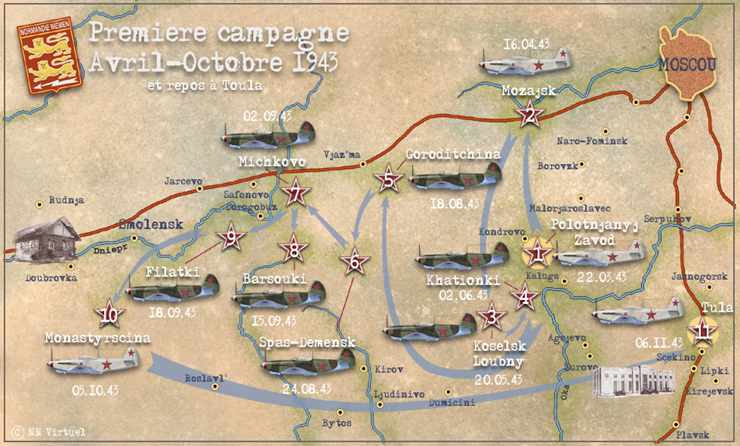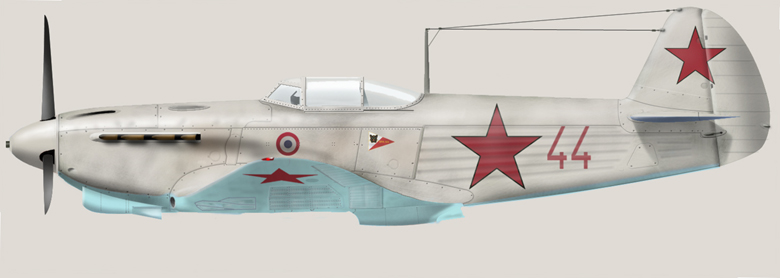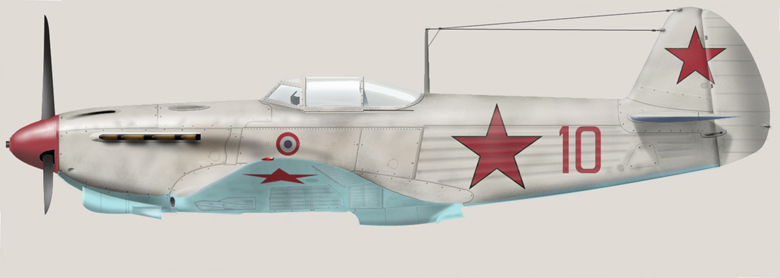Yak 1 B Série 127: Questions / Réponses
Publié : mer. août 31, 2016 6:20 pm
J'ouvre ce post à fin de centraliser toutes les infos sur cet appareil en cours de développement.





Caractéristique technique:
Indicated stall speed in flight configuration: 153..169 km/h
Indicated stall speed in takeoff/landing configuration: 132..145 km/h
Dive speed limit: 720 km/h
Maximum load factor: 10.3 G
Stall angle of attack in flight configuration: 18 °
Stall angle of attack in landing configuration: 15.6 °
Maximum true air speed at sea level, engine mode - Nominal, 2550 RPM: 530 km/h
Maximum true air speed at 2000 m, engine mode - Nominal, 2700 RPM: 567 km/h
Maximum true air speed at 4500 m, engine mode - Nominal, 2700 RPM: 600 km/h
Service ceiling: 10600 m
Climb rate at sea level: 17.0 m/s
Climb rate at 3000 m: 15.0 m/s
Climb rate at 6000 m: 9.5 m/s
Maximum performance turn at sea level: 19.0 s, at 270 km/h IAS.
Maximum performance turn at 3000 m: 24.1 s, at 270 km/h IAS.
Flight endurance at 3000 m: 2.0 h, at 350 km/h IAS.
Takeoff speed: 160..190 km/h
Glideslope speed: 195..205 km/h
Landing speed: 135..145 km/h
Landing angle: 12 °
Note 1: the data provided is for international standard atmosphere (ISA).
Note 2: flight performance ranges are given for possible aircraft mass ranges.
Note 3: maximum speeds, climb rates and turn times are given for standard aircraft mass.
Note 4: climb rates and turn times are given for Nominal (2700 RPM) power.
Engine:
Model: M-105PF
Maximum power in Nominal mode (2550 RPM) at sea level: 1240 HP
Maximum power in Nominal mode (2700 RPM) at sea level: 1210 HP
Maximum power in Nominal mode (2700 RPM) at 800 m: 1260 HP
Maximum power in Nominal mode (2700 RPM) at 2700 m: 1200 HP
Engine modes:
Nominal (unlimited time): 2550/2700 RPM, 1050 mm Hg
Water rated temperature in engine output: 70..85 °C
Water maximum temperature in engine output: 100 °C
Oil rated temperature in engine output: 90..100 °C
Oil maximum temperature in engine output: 115 °C
Supercharger gear shift altitude: 2300 m
Empty weight: 2322 kg
Minimum weight (no ammo, 10% fuel): 2543 kg
Standard weight: 2887 kg
Maximum takeoff weight: 3117 kg
Fuel load: 304 kg / 408 l
Useful load: 795 kg
Forward-firing armament:
20mm gun "SsVAK", 140 rounds, 800 rounds per minute, nose-mounted
12.7mm machine gun "UB", 220 rounds, 1000 rounds per minute, synchronized
Bombs:
2 x 50 kg general purpose bombs "FAB-50sv"
2 x 104 kg general purpose bombs "FAB-100M"
Length: 8.5 m
Wingspan: 10 m
Wing surface: 17.15 m^2
Combat debut: April 1943
2 x 50 kg General Purpose Bombs FAB-50sv
Additional mass: 120 kg
Ammunition mass: 100 kg
Racks mass: 20 kg
Estimated speed loss before drop: 23 km/h
Estimated speed loss after drop: 13 km/h
2 x 104 kg General Purpose Bombs FAB-100M
Additional mass: 228 kg
Ammunition mass: 208 kg
Racks mass: 20 kg
Estimated speed loss before drop: 31 km/h
Estimated speed loss after drop: 13 km/h
Landing light for night flights
Additional mass: 2 kg
Estimated speed loss: 0 km/h
RPK-10 fixed loop radio compass for navigation with radio beacons
Additional mass: 10 kg
Estimated speed loss: 0 km/h
Operation features:
- Engine has a two-stage mechanical supercharger which must be manually switched at 2300m altitude.
- Engine mixture control is manual; it is necessary to lean the mixture if altitude is more than 3-4 km for optimal engine operation. Also, leaning the mixture allows a reduction in fuel consumption during flight.
- Engine RPM has an automatic governor and it is maintained at the required RPM corresponding to the governor control lever position. The governor automatically controls the propeller pitch to maintain the required RPM.
- Water and oil radiator shutter control is manual.
- Airplane has only a flight-control trimmer on the pitch.
- Landing flaps have a pneumatic actuator. Flaps can only be fully extended; gradual extending is impossible. Due to the weak force of the actuator the extended landing flaps may be pressed upwards by the airflow if the airspeed is more than 220 km/h. Remember that the flaps will not extend fully in case of high speed. In case of a high-speed landing approach the flaps may extend a few steps further right before landing.
- Airplane has a tailwheel control system which is unlocked by the rudder if the rudder pedal is pressed more than 75% of its range. The tailwheel remains locked if pedals are deflected less than 75%. Because of this, it is necessary to avoid large rudder pedal inputs when moving at high speed.
- Airplane has differential pneumatic wheel brakes with shared control lever. This means that if the brake lever is held and the rudder pedal the opposite wheel brake is gradually released causing the plane to swing to one side or the other.
- Fuel gauges are installed on left and right wing fuel tanks, outside of the cockpit. They show remaining fuel level only when there is less than 80 liters of fuel left in the tank.
- It is impossible to open or close the canopy at high speed due to strong airflow. The canopy has no emergency release, so bail out requires the speed drop before it.
- The control system for the wing-mounted bomb racks only allows releasing of both bombs together.
Vidéo de familiarisation de Requiem:





Caractéristique technique:
Indicated stall speed in flight configuration: 153..169 km/h
Indicated stall speed in takeoff/landing configuration: 132..145 km/h
Dive speed limit: 720 km/h
Maximum load factor: 10.3 G
Stall angle of attack in flight configuration: 18 °
Stall angle of attack in landing configuration: 15.6 °
Maximum true air speed at sea level, engine mode - Nominal, 2550 RPM: 530 km/h
Maximum true air speed at 2000 m, engine mode - Nominal, 2700 RPM: 567 km/h
Maximum true air speed at 4500 m, engine mode - Nominal, 2700 RPM: 600 km/h
Service ceiling: 10600 m
Climb rate at sea level: 17.0 m/s
Climb rate at 3000 m: 15.0 m/s
Climb rate at 6000 m: 9.5 m/s
Maximum performance turn at sea level: 19.0 s, at 270 km/h IAS.
Maximum performance turn at 3000 m: 24.1 s, at 270 km/h IAS.
Flight endurance at 3000 m: 2.0 h, at 350 km/h IAS.
Takeoff speed: 160..190 km/h
Glideslope speed: 195..205 km/h
Landing speed: 135..145 km/h
Landing angle: 12 °
Note 1: the data provided is for international standard atmosphere (ISA).
Note 2: flight performance ranges are given for possible aircraft mass ranges.
Note 3: maximum speeds, climb rates and turn times are given for standard aircraft mass.
Note 4: climb rates and turn times are given for Nominal (2700 RPM) power.
Engine:
Model: M-105PF
Maximum power in Nominal mode (2550 RPM) at sea level: 1240 HP
Maximum power in Nominal mode (2700 RPM) at sea level: 1210 HP
Maximum power in Nominal mode (2700 RPM) at 800 m: 1260 HP
Maximum power in Nominal mode (2700 RPM) at 2700 m: 1200 HP
Engine modes:
Nominal (unlimited time): 2550/2700 RPM, 1050 mm Hg
Water rated temperature in engine output: 70..85 °C
Water maximum temperature in engine output: 100 °C
Oil rated temperature in engine output: 90..100 °C
Oil maximum temperature in engine output: 115 °C
Supercharger gear shift altitude: 2300 m
Empty weight: 2322 kg
Minimum weight (no ammo, 10% fuel): 2543 kg
Standard weight: 2887 kg
Maximum takeoff weight: 3117 kg
Fuel load: 304 kg / 408 l
Useful load: 795 kg
Forward-firing armament:
20mm gun "SsVAK", 140 rounds, 800 rounds per minute, nose-mounted
12.7mm machine gun "UB", 220 rounds, 1000 rounds per minute, synchronized
Bombs:
2 x 50 kg general purpose bombs "FAB-50sv"
2 x 104 kg general purpose bombs "FAB-100M"
Length: 8.5 m
Wingspan: 10 m
Wing surface: 17.15 m^2
Combat debut: April 1943
2 x 50 kg General Purpose Bombs FAB-50sv
Additional mass: 120 kg
Ammunition mass: 100 kg
Racks mass: 20 kg
Estimated speed loss before drop: 23 km/h
Estimated speed loss after drop: 13 km/h
2 x 104 kg General Purpose Bombs FAB-100M
Additional mass: 228 kg
Ammunition mass: 208 kg
Racks mass: 20 kg
Estimated speed loss before drop: 31 km/h
Estimated speed loss after drop: 13 km/h
Landing light for night flights
Additional mass: 2 kg
Estimated speed loss: 0 km/h
RPK-10 fixed loop radio compass for navigation with radio beacons
Additional mass: 10 kg
Estimated speed loss: 0 km/h
Operation features:
- Engine has a two-stage mechanical supercharger which must be manually switched at 2300m altitude.
- Engine mixture control is manual; it is necessary to lean the mixture if altitude is more than 3-4 km for optimal engine operation. Also, leaning the mixture allows a reduction in fuel consumption during flight.
- Engine RPM has an automatic governor and it is maintained at the required RPM corresponding to the governor control lever position. The governor automatically controls the propeller pitch to maintain the required RPM.
- Water and oil radiator shutter control is manual.
- Airplane has only a flight-control trimmer on the pitch.
- Landing flaps have a pneumatic actuator. Flaps can only be fully extended; gradual extending is impossible. Due to the weak force of the actuator the extended landing flaps may be pressed upwards by the airflow if the airspeed is more than 220 km/h. Remember that the flaps will not extend fully in case of high speed. In case of a high-speed landing approach the flaps may extend a few steps further right before landing.
- Airplane has a tailwheel control system which is unlocked by the rudder if the rudder pedal is pressed more than 75% of its range. The tailwheel remains locked if pedals are deflected less than 75%. Because of this, it is necessary to avoid large rudder pedal inputs when moving at high speed.
- Airplane has differential pneumatic wheel brakes with shared control lever. This means that if the brake lever is held and the rudder pedal the opposite wheel brake is gradually released causing the plane to swing to one side or the other.
- Fuel gauges are installed on left and right wing fuel tanks, outside of the cockpit. They show remaining fuel level only when there is less than 80 liters of fuel left in the tank.
- It is impossible to open or close the canopy at high speed due to strong airflow. The canopy has no emergency release, so bail out requires the speed drop before it.
- The control system for the wing-mounted bomb racks only allows releasing of both bombs together.
Vidéo de familiarisation de Requiem:


